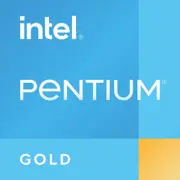Intel Pentium Gold G5500

Intel Pentium Gold G5500: A Budget Processor for Basic Tasks
April 2025
1. Key Specifications: Architecture, Process Technology, and Key Features
The Intel Pentium Gold G5500 processor, released in 2018, remains a popular choice for budget PCs due to its balance of price and performance.
Architecture and Process Technology
- Codename: Coffee Lake (14 nm).
- Cores/Threads: 2 cores, 4 threads (Hyper-Threading).
- Cache: 4 MB L3.
- Base Frequency: 3.8 GHz (without Turbo Boost).
Despite its outdated 14nm process technology, this processor demonstrates stable performance for simple tasks. Hyper-Threading allows for more efficient load distribution, which is critical for a dual-core system.
Integrated Graphics
- Intel UHD Graphics 630: Supports 4K@60 Hz via HDMI/DisplayPort, hardware video decoding (H.265, VP9).
- Gaming Performance: In games like CS:GO or Dota 2, it delivers 30-40 FPS on low settings in Full HD.
Benchmarks
- Geekbench 6: 755 (single-core), 1496 (multi-core).
For comparison, the AMD Athlon 3000G scores approximately ~650 and ~1250, respectively.
2. Compatible Motherboards: Sockets and Chipsets
Socket: LGA 1151-v2 (not compatible with motherboards for 6th and 7th generation Intel processors).
Recommended Chipsets:
- H310/B365: Budget option (ASRock H310CM-HDV, ~$60).
- B360/B365: Supports USB 3.1 Gen 2 and more PCIe lanes (ASUS Prime B360M-A, ~$80).
- Z390: For enthusiasts, but redundant for Pentium (Gigabyte Z390 UD, ~$120).
Important:
- Update the BIOS before installation if the motherboard was released before 2018.
- Avoid H310 series chipsets with limited VRM power — they may not fully utilize the processor's potential.
3. Memory Support: DDR4 and Dual-Channel Mode
- Memory Type: DDR4-2400 (officially), but many boards allow for overclocking to 2666 MHz.
- Maximum Capacity: 64 GB (8-16 GB is practically sufficient).
- Mode: Be sure to use two modules for dual-channel mode (e.g., 2x4 GB).
Example: A Crucial DDR4-2400 8 GB kit (2x4 GB) costs around ~$35.
4. Power Supply: Power Calculation
With a TDP of 54 W and no discrete GPU, a power supply of 300-400 W is sufficient.
Recommendations:
- For Basic Builds: EVGA 400 W3 (80+ Bronze, ~$40).
- With Upgrade Headroom: Corsair CX450 (450 W, ~$55).
Tip: Don’t skimp on the power supply — low-quality models (like those from Apevia) can damage components.
5. Pros and Cons of the Pentium Gold G5500
Pros:
- Price: ~$60-80 (new).
- Energy Efficiency: Suitable for compact cases.
- UHD 630 Graphics: Great for replacing a graphics card in office PCs.
Cons:
- 2 Cores: Multitasking is limited (e.g., streaming + gaming – not an option).
- 14 nm: Higher heat output compared to 10 nm counterparts.
6. Use Case Scenarios
Office and Multimedia:
- Document work, browsing (20+ tabs), Zoom conferences.
- Playing 4K video via VLC or Kodi.
Light Gaming:
- Minecraft, Among Us, Stardew Valley — comfortable gameplay at medium settings.
Servers:
- NAS or home media server (e.g., based on TrueNAS).
Limitations:
- Video editing (DaVinci Resolve) or 3D rendering (Blender) will be extremely slow.
7. Comparison with Competitors
AMD Athlon 3000G:
- Pros: Cheaper (~$50), Vega 3 graphics.
- Cons: Weaker in single-core tests (~15%).
Intel Celeron G5905:
- Pros: Price ~$45.
- Cons: No Hyper-Threading, 3.5 GHz frequency.
Conclusion: The Pentium Gold G5500 is optimal if you need a balance of price and support for modern technologies (4K, DDR4).
8. Build Tips
- Cooler: The boxed cooler is sufficient, but for quiet operation, consider the DeepCool GAMMAXX 400 (~$20).
- Storage: SSD is a must (Kingston A400 240 GB, ~$25).
- Case: Micro-ATX (Fractal Design Core 1100, ~$50).
Example Build:
- Motherboard: ASRock H310CM-HDV ($60).
- Memory: 8 GB DDR4 ($35).
- PSU: EVGA 400 W3 ($40).
- Total: ~$250 excluding storage and case.
9. Final Conclusion: Who Should Consider the Pentium Gold G5500?
This processor is a choice for:
1. Office PCs: Reliability and low power consumption.
2. Home Media Centers: 4K video, streaming.
3. Budget Builds for Study: Text work, browsing, light applications.
Why You Shouldn't Choose It:
- If you plan to play AAA graphics games.
- For professional tasks (programming, editing).
Alternative for 2025: Consider the Intel Processor N100 (newer, 7 nm, but costlier at ~$120).
The Pentium Gold G5500 is an example of a successful budget solution that, despite its age, remains relevant for less demanding users. Its strengths lie in simplicity, stability, and minimalism.
Basic
CPU Specifications
Memory Specifications
GPU Specifications
Miscellaneous
Benchmarks
Compared to Other CPU
Share in social media
Or Link To Us
<a href="https://cputronic.com/en/cpu/intel-pentium-gold-g5500" target="_blank">Intel Pentium Gold G5500</a>